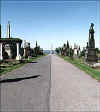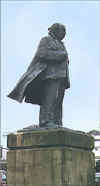
Bradford City Hall.
It's hard to imagine that Bradford, a giant among industrial towns, is less than an hours drive away from the Yorkshire Dales. The city used to be the wool capital of the world. Much of the splendid Victorian architecture remains today. The city has come in for a lot of stick over the years, but has emerged almost unscathed. There is plenty to see and do in and around Bradford, now a cosmopolitan city. On a single web page it's difficult to relate this diverse city with a population of around half a million. Because of its multi-cultural inhabitants, you can dine on the finest Asian cuisine in the land!
The city was born of the Industrial Revolution. You can still see rows and rows of
terraced houses and mill chimneys dotting the skyline. The Town Hall (now City Hall) was
built between 1870 and 1873. It is said to be modelled on the campanile (bell tower) of
the Palazzo Vecchio in the city of Florence, Italy. At the front of the building you will
see 35 life-size statues of kings and queens of England, starting with William the
Conqueror. Elizabeth I, Victoria, Charles II and William II are also there. The only
non-Royal is Oliver Cromwell.
The mill chimney at 'Listers' is a great monument to the once thriving textile industry. It weighs 8,000 tonnes and is 250 feet high. It was Christened 'Lister's Pride' and has been likened to the campanile of San Marco in Venice.
Cartwright Hall (Click to enlarge)
Cartwright Hall, with its beautiful grounds, was built in 1904. An Art gallery in the Baroque style. Consists of mainly C19th & C20th British Art with some International contemporary prints. You will also see a permanent collection of South Asian Art. Other exhibitions are held throughout the year.

Bradford Cathedral
The Church of St. Peter, Bradford's most ancient place of worship, became the Cathedral after the First World War. Built in the style of a C15th Yorkshire church, it has seen many changes and much rebuilding over the years. Up until the early C18th it had a thatched roof. During the English Civil War, Bradford was besieged and came under cannon attack. The resourceful Bradfordians hung woolsacks from the church windows to protect the building.
It was the health hazards caused by overcrowded graveyards in the C19th that made
Bradford open Undercliffe Cemetery. The large Anglican
section was consecrated in 1845. This wonderful necropolis, has extensive views over the
city. You will see splendid sculpture depicting the monumental mason's art. Tombs fit for
Pharaohs, finely decorated obelisks, extravagant mausoleums and huge columns abound. A
Bradford businessman, Joseph Smith, was buried here in 1858, his granite obelisk stands 22
feet high! Some of Bradford's notable citizens are resting here, along with veterans of
famous conflicts such as Waterloo, the Crimea and the Indian Mutiny.
How ironic, and sad, that in an unmarked grave in West Bowling Cemetery lies the body of Arthur Blackburn, a tramp. It is him that Family Tree addicts have to thank for making their lives easier. In the 1920's and 1930's Arthur combed the graveyards in Bradford and copied, then indexed, by hand, all the inscriptions. Over one hundred hand-written volumes of his are in Bradford's Central Library.
Undercliffe Cemetery (click to enlarge)
Perhaps there is nowhere better to visit than Bradford's Industrial Museum to get a feel of bygone days. Originally a worsted spinning mill built in 1875. It is now used to recreate life at the turn of the century. A row of 'Back-to-Back' houses (see photo'), the Mill Owner's House, exhibitions, working machinery and Shire horses at work. Also in the museum you will find a superb collection of the Bradford made Jowett cars. Locally made motorcycles are also on display. You can also grab a bite to eat here. Admission is free. Closed Mondays.
The Museum of Photography, Film and Television gives the city national recognition.
Another 'must' is the Victorian 'model' village of Saltaire. Sir Titus Salt built the village for his workers between 1851-1876. It is now an award winning conservation area.

Back-to-back houses
Bradford's famous folk
These include Frederick Delius one of England's most important composers. Politicians Denis Healey and Barbara Castle. Nobel Prize-winner Sir Edward Victor Appleton, he received the Nobel Prize for physics in 1947. Astronomer Professor Sir Fred Holye. One of the 'greatest tutors' of Clare College, Cambridge, Sir Henry Thirkill. Artist David Hockney. The distinguished historian Sir Alan Bullock. Pauline Mathews, better known as singer Kiki Dee. Bradford has produced some good writers. John Braine wrote 'Room at the Top' this was published in 1957 and went on to become a successful movie, much of it was shot in Bradford, it won two Oscars. John Boynton Priestley, known as Jack or simply J.B. He was one of the most prolific and foremost writers of the 20th century. He was made a Freeman of Bradford. He died in 1984 and is buried at Hubberholme. You may not have heard of Joseph Hobson Jagger, a textile worker from a mill in Shelf, Bradford. Such was his knowledge of wooden spindles and that they were subject to wear and tear that he decided to go to Monte Carlo in the south of France. Here, in the famous casino's he studied the roulette wheels, and found some to be biased. He was good with figures and began betting, subsequently winning millions of francs! This was the foundation for the song 'The man who broke the bank at Monte Carlo.'
In his book 'English Journey' J.B.Priestley says this about Bradford:
".........it has the good fortune to be on the edge of some of the most
enchanting country in England. A sharp walk of less than an hour from more than one tram
terminus will bring you to the moors, wild virgin highland, and every mill and warehouse
will be out of sight and the whole city forgotten. However poor you are in Bradford, you
need never be walled in, bricked up, as folk must be in London. Those great bare heights,
with a purity of sky above and behind them, are always there, waiting for you. And not
very far beyond them, the authentic dale country begins. There is no better country in
England. There is everything a man can possibly want in these dales, from trout streams to
high wild moorland walks, from deep woods to upland miles of heather and ling. I know no
other countryside that offers you such entrancing variety. So if you can use your legs and
have a day now and then to yourself, you need never be unhappy long in Bradford. The hills
and moors and dales are there for you. Nor do they wait in vain. The Bradford folk have
always gone streaming out to the moors."



